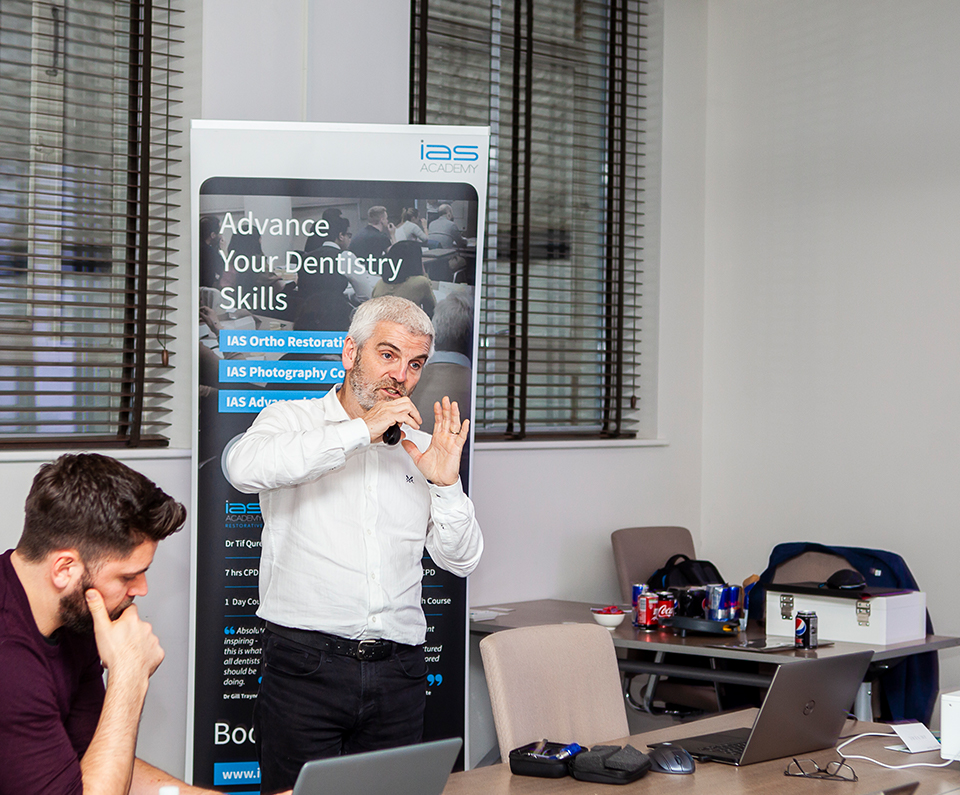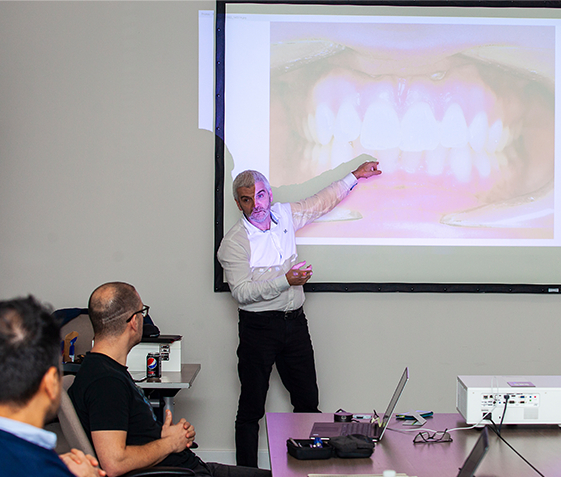
Trailer

United Kingdom
Clear Aligners Diploma
£14,400
CPD - 147 Hours
Next Course - 02 Jul 2026 - 19 Feb 2028
View course datesDiploma in Clear Aligners (EduQual Level 7)
The authoritative year-long course for profitable, confident, clear aligner mastery
"When we say this course is comprehensive, we mean it - there is no training that could take your aligner skills any further. Join us to take clear aligner possibilities to the absolute limit with fully digital workflows for ANY system and discover the blueprint for profitable in-house aligner production."
JOSH ROWLEY
Clear Aligner Diploma Course Leader
Ready for Expert-Level Clear Aligner Provision?
Are you ready to take your clear aligner skills to the upper limit with the freedom to use any clear aligner system?
Want to discover efficient digital workflows that achieve consistently excellent results with any scanner?
Maybe you’d like to tap into the profitable world of in-house aligner production but are unsure where to begin.
Then IAS Academy’s Clear Aligner Diploma is for you.

Take Clear Aligner Therapy to the Limit with IAS Academy
Clear aligner therapy has come a long way since first arriving in our clinics more than two decades ago.
Offering effective treatment for a growing number of indications from the simple to the complex, a vast array of brands and systems now compete in one of dentistry’s most competitive sectors.
The flagship Clear Aligner Diploma (EduQual Level 7) is designed to be the most authoritative and comprehensive education course available for this highly sought-after treatment.
Featuring 14 packed modules of theoretical and hands-on training, including live planning and staging on patients, the diploma leaves no stone unturned in uncovering everything from assessment, planning and treatment to expert-level, in-house aligner production.
Every delegate gets ten specialist-mentored cases from assessment to retention on our secure support platform
Training takes delegates through treatment with any clear aligner system, allowing them to determine, design and refine digital workflows for profitable, confident, clear aligner mastery.


Bias-Free, Agnostic Training
The clear aligner diploma comprises independent, bias-free training you can apply to treatment with any clear aligner system, including Invisalign, ClearCorrect, SureSmile, Spark, Reveal and many more.







Towards Digital Workflows
Training allows you to define and refine your ideal digital workflow, including digital in-house aligner production. All digital workflow components are system-agnostic and readily adaptable to your scanner and planning platform of choice.

Unlock Profitable Aligner Production
The diploma presents delegates with a simple workflow for in-house aligner production, allowing dentists to create their own profitable branded aligners or undertake hybrid cases in conjunction with existing systems.

Live Planning, Staging and Sequencing
Join IAS Academy experts for live planning, staging and sequencing demonstrations with real-life cases, and apply what you learn to your patients with the diploma’s mentored case assessment modules.

The Authoritative Clear Aligner Course
From simple to advanced treatment and beyond to in-house aligner production, the Clear Aligner Diploma is the last word in expert-level clear aligner training—no further courses are necessary.
Course Format
Training is delivered in 14 modules over the year. Each module is worth six credits and is equivalent to around five hours of independent study. Completion of the course gives delegates 120 credits at level seven.
Training consists of:
- Interactive didactic lectures
- Face-to-face and online seminars
- Planning, staging and sequencing demonstrations with real cases
- Practical training
- Self-directed learning
- Project work, including group audits, article and journal reviews, presentations and discussions
- Clinical hands-on training with virtual one-to-one mentoring on at least 10 treated cases

Learning Outcomes - Theory and Knowledge
By the end of this postgraduate diploma-level programme, learners should gain a comprehensive working knowledge of:
- The basic sciences relevant to orthodontics and evidence-based care
- The limitations of assessment and diagnostic methods and orthodontic treatment
- The professional commitment to lifelong learning to update practice continually
- The genetic and environmental factors in orthodontics
- The environmental, genetic, psychological and psychosocial factors affecting orthodontic care
- The biomechanics of orthodontic aligner treatment, including risk factors resulting from treatment
- Materials and their application in aligner orthodontics
- The factors affecting orthodontic care in adults
- Multidisciplinary care in aligner and restorative treatment
- Your limitations as a practitioner and when to refer

Learning Outcomes - Patient Communication
Delegates will be able to:
- Communicate effectively about patients' treatment requirements
- Explain the risks and benefits of treatment
- Recognise the need for empathetic communication and valid consent
- Recognise the rights of patients and carers in deciding on treatment

Learning Outcomes - Practical
Students will gain a complete practical skillset for effective clear aligner treatment, including:
- Undertaking the appropriate assessments, including clinical records, specialist investigations (e.g radiographs) and their interpretation
- Methods for assessing need and outcomes of orthodontic treatment
- A complete understanding of the biomechanics of clear aligner orthodontic treatment, including risk factors resulting from treatment
- Use of appropriate indices to assess orthodonitc need and outcome
- Designing and applying appropriate retention
- Aligner design and production
Course Syllabus
During the course, every delegate will get one-to-one mentoring by a specialist for 10 clear aligner cases on our support platform.

Module 1:
Craniofacial Growth and Development
- Bone formation and remodelling in health and disease
- Normal and abnormal development of teeth and surrounding structures
- Normal and abnormal facial development, including common malformations
- Craniofacial biology, growth and development in relation to patient assessment
- Facial growth patterns in relation to patient assessment and treatment

Module 2:
Research, Information and Communication Technology
- Accessing research evidence using IT&C
- Critically appraising published research
- Evidence-based approaches to the delivery of patient care
- The importance of balancing clinical evidence

Module 3:
Imaging Techniques (Radiographic and non-Radiographic)
- Operation of imaging equipment within current legislation
- Imaging techniques for diagnosis and management of orthodontic patients
- Legal requirements for protecting patients and staff

Module 4:
Development of the Dentition and Tooth Movement
- Normal and abnormal dental development
- The developmental stage of the dentition
- Factors responsible for developmental abnormalities
- Assessment of the craniofacial skeleton, dentition and soft tissues
- Current techniques for taking analysing and interpreting images
- Explaining the development of dentition to patients
- Craniofacial biology in the delivery of orthodontic care

Module 5:
Clear Aligner Orthodontic Materials and Biomechanics
- Clear aligner materials - advantages and disadvantages
- Biomechanics for tooth movement
- Desired and undesired tooth movement
- Dental materials and biomechanics in clear aligner orthodontics in relation to treatment sequences, treatment progression and communication
- The iatrogenic effects of orthodontics

Module 6:
Diagnostic Procedures
- Effective clinical assessment and diagnosis of malocclusion
- Collating, interpreting and analysing appropriate clinical records as part of clinical diagnosis
- Systematic approaches to assessment and diagnosis
- Communicating with patients about the aetiology of malocclusion

Module 7:
Treatment Planning & Cephalometrics
- Identifying patients’ expectations
- Evaluating treatment options and clear aligner alternatives
- Knowing when to treat and when to refer
- Setting out treatment aims
- Effective treatment planning
- Cephalometric analysis and superimposition techniques
- Growth and the influence of treatment on growth
- Predicting growth in the development of malocclusion
- Selecting and undertaking appropriate cephalometric analysis
- Interpreting cephalometric data for treatment planning
- Assessment of growth and treatment change
- Cephalometric information - influences on treatment

Module 8:
Long-Term Effects of Orthodontic Treatment
- Treatment and post-treatment stability
- Malocclusion types and their relation to post-treatment stability
- Current research and controversies in retention
- The importance of post-treatment change
- Selection of appropriate evidence-based retention
- Explaining retention as part of the consent process

Module 9:
Epidemiology in Orthodontics
- Ethnic, gender and social influences on orthodontic treatment provision
- The effect of peer pressure and self-esteem on treatment decisions
- Incidence and distribution of malocclusion in the population
- The need and demand for orthodontic care
- The importance of psychosocial factors and epidemiology in orthodontic care

Module 10:
Clear Aligners
- Clear aligner materials, mechanics and limitations
- Fitting and activating clear aligners
- Attachment placement
- Managing clear aligner cases
- Communicating the advantages and disadvantages of clear aligners

Module 11:
Orthodontic Anchorage
- Orthodontic anchorage and methods of increasing or reducing anchorage
- Intraoral anchorage design and application

Module 12:
Retention and Retention Appliances
- Post-retention changes after active tooth movement
- Post-treatment orthodontic retention
- Selecting, designing, fitting and monitoring retention appliances
- Retention appliance choice, regime and duration - the evidence
- Communicating the importance of post-treatment retention

Module 13:
Adult Orthodontics
- Dental health considerations in adult patients
- Adjunctive therapy - goals, principles and procedures
- Managing adults’ expectations and motivation during orthodontic treatment
- Integrating periodontal, restorative and temporomandibular joint considerations into treatment planning and treatment provision
- Identifying and communicating appropriate adult orthodontic treatment

Module 14:
Orthodontics and Restorative Dentistry
- The importance of an integrated treatment plan for joint orthodontic/restorative care
- Timing of orthodontic treatments in relation to restorative care
- Knowing when and where to refer
- Liaising with colleagues on orthodontic/restorative treatments
Entry Requirements

BDS or equivalent primary dental degree

Evidence of registration with the relevant national regulatory body (GDC registration in the UK)

Qualified for at least three years

Completed a minimum of 10 clear aligner cases with any brand or system. You may be required to provide evidence of this.

Degree Certificate - a copy of the primary dental degree certificate showing qualifications or a translation for non-UK registered dentists

Access to a suitable clear aligner patient base
Book Now
Full Course Dates
This is a modular course that spans over multiple dates which must be booked as a whole.
Individual Module Dates
Please note, these modules cannot be booked individually and must be booked as a whole.
Meet the Lecturers


Josh Rowley
Dr Josh Rowley graduated from The University of Dundee in 2014 and after being nominated twice in the years before, went on to win Best Young Dentist and Best Smile Makeover at the Dentistry Scotland Awards in 2020.
Now a specialist orthodontist, Josh is a certified provider of SureSmile Aligners. His commitment to orthodontics is proven further with his memberships at the Faculty of Dental Surgery of the Royal College of Surgeons Edinburgh and The Royal Australasian College of Dental Surgeons.
Dr Rowley’s interests lie in cutting edge-digital techniques in both orthodontics and digital smile design as well as elements of general dentistry. He has shown a passion for complex cases including growth modification for growing children, aesthetic facial surgical enhancements for dental malocclusions, facial disharmony and breathing disturbances.
- Specialist Orthodontist
- Best Young Dentist Award Winner
- Has had worldwide training
- Slow Dentistry Member


Pravesh Solanki
Following a post-medical PhD at Oxford University in 2006, Prav Solanki was destined for big things in scientific research.
But all that changed when his brother asked for help launching a new dental practice, and Prav caught the marketing bug.
He now applies a scientist’s eye to marketing as founder and director of The Fresh —one of the UK’s leading growth agencies for the dental and healthcare sectors.
Prav is also the owner of several successful dental and implant clinics and healthcare brands.
His lively keynote talks on practice growth and marketing have been a hit with audiences at events, including the ADI Team Congress, the BACD conference, the Dental Technology Showcase, and many more.
- 16+ Years Experience In Dental Business
- Experience in Growth & Exit Strategies
- Director Of The Fresh Growth Agency
- Founder of Leadflo Dental CRM
- Multi-practice Owner
- Business & Life Coach
